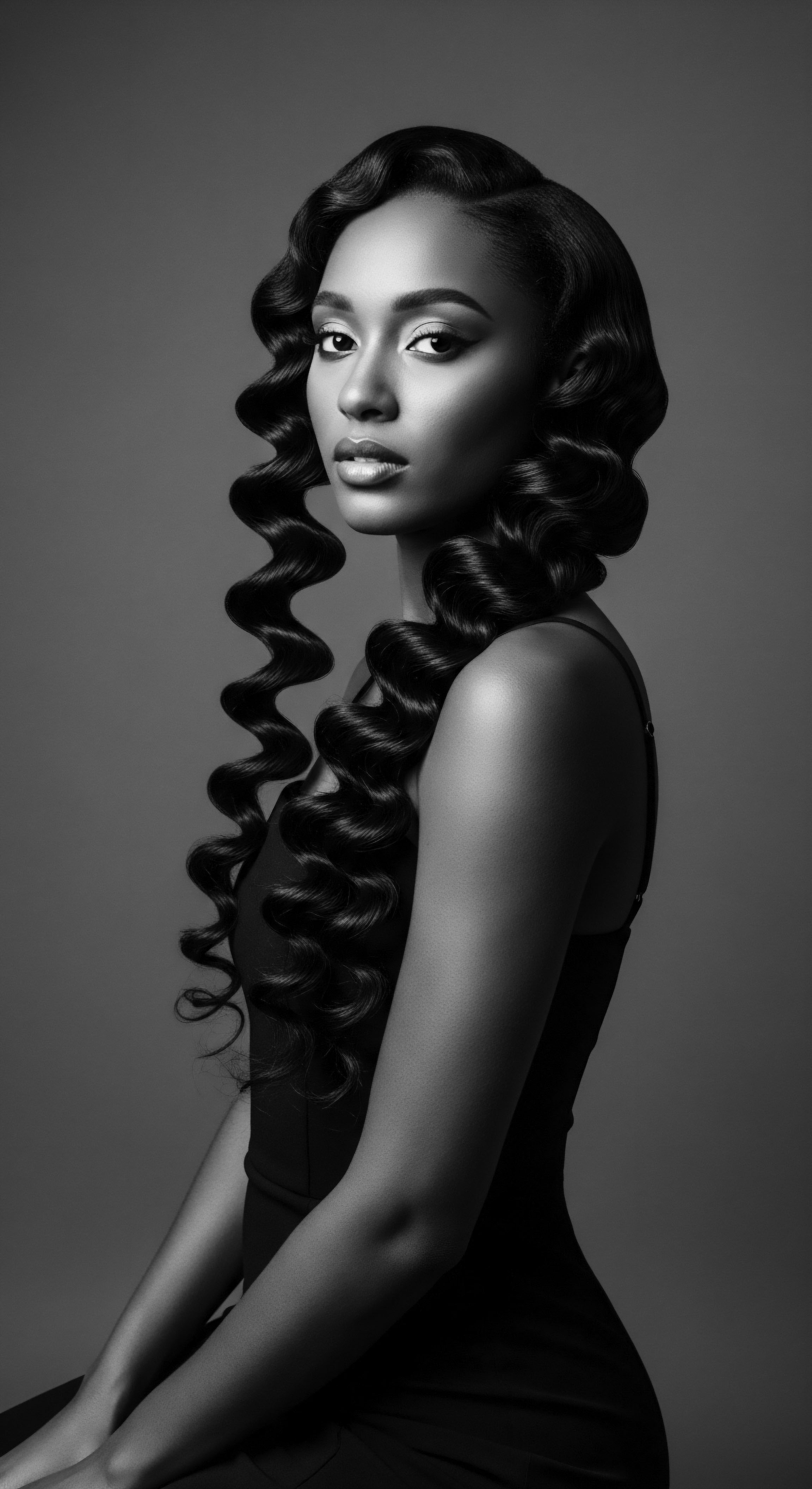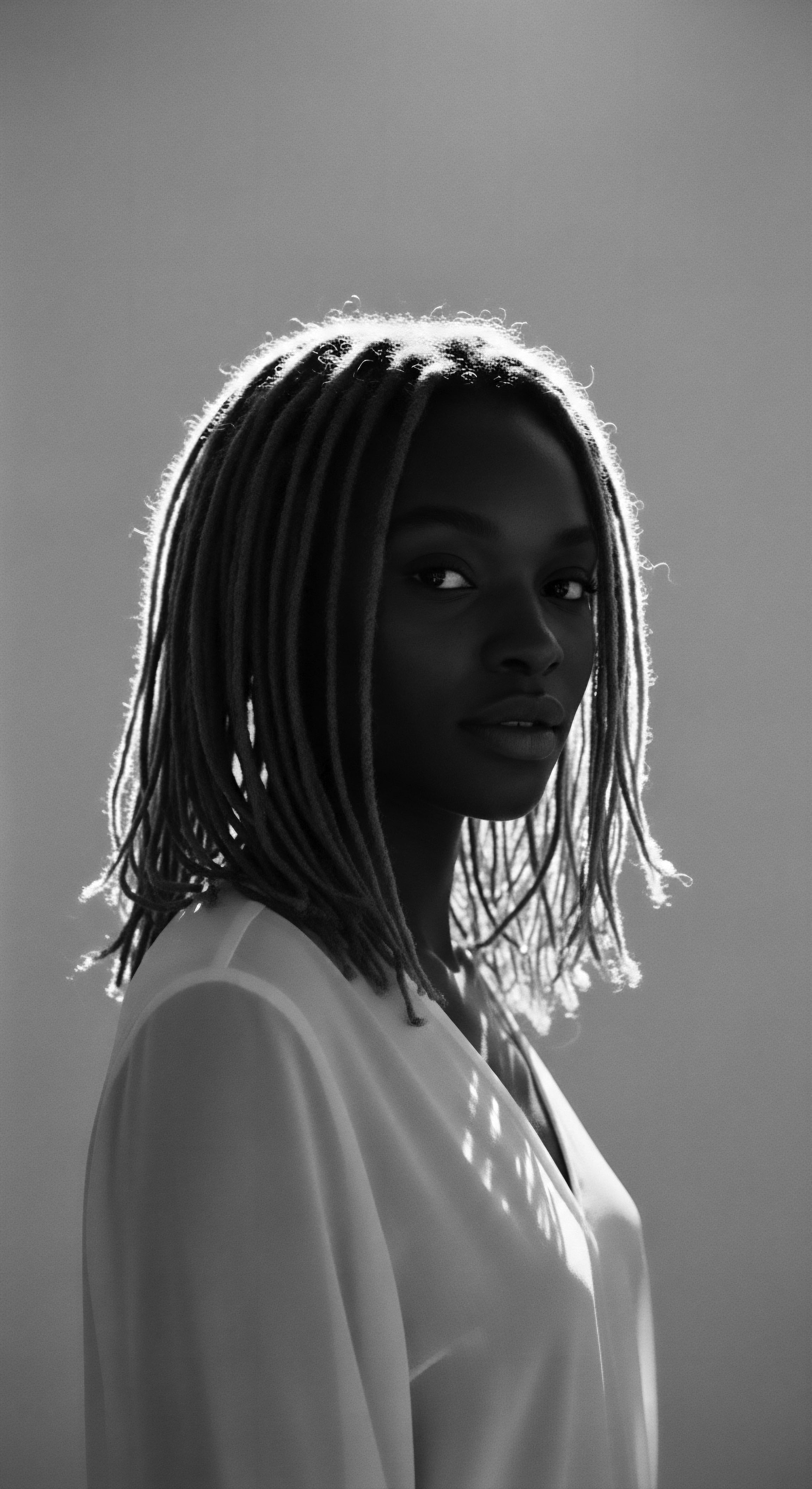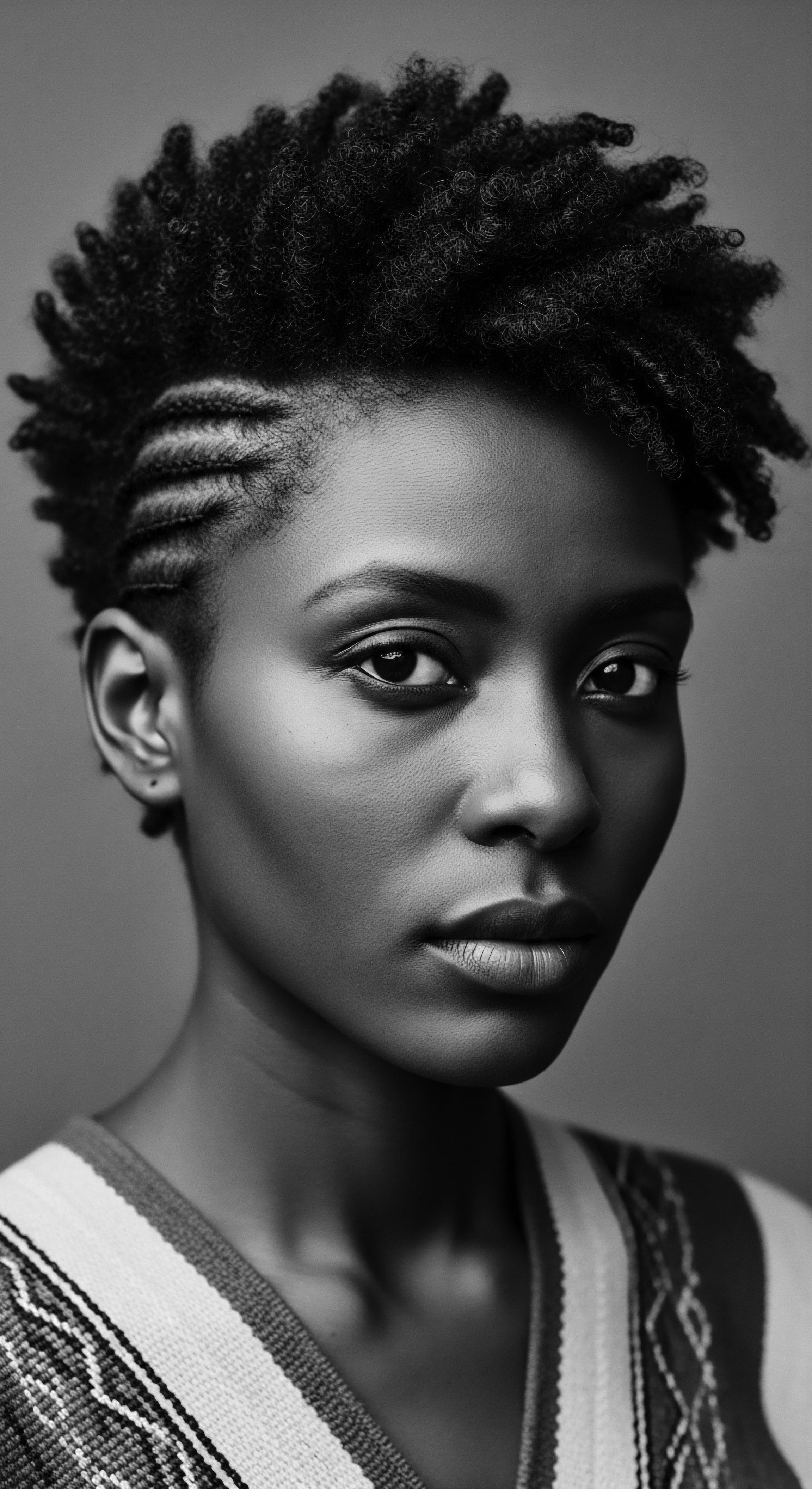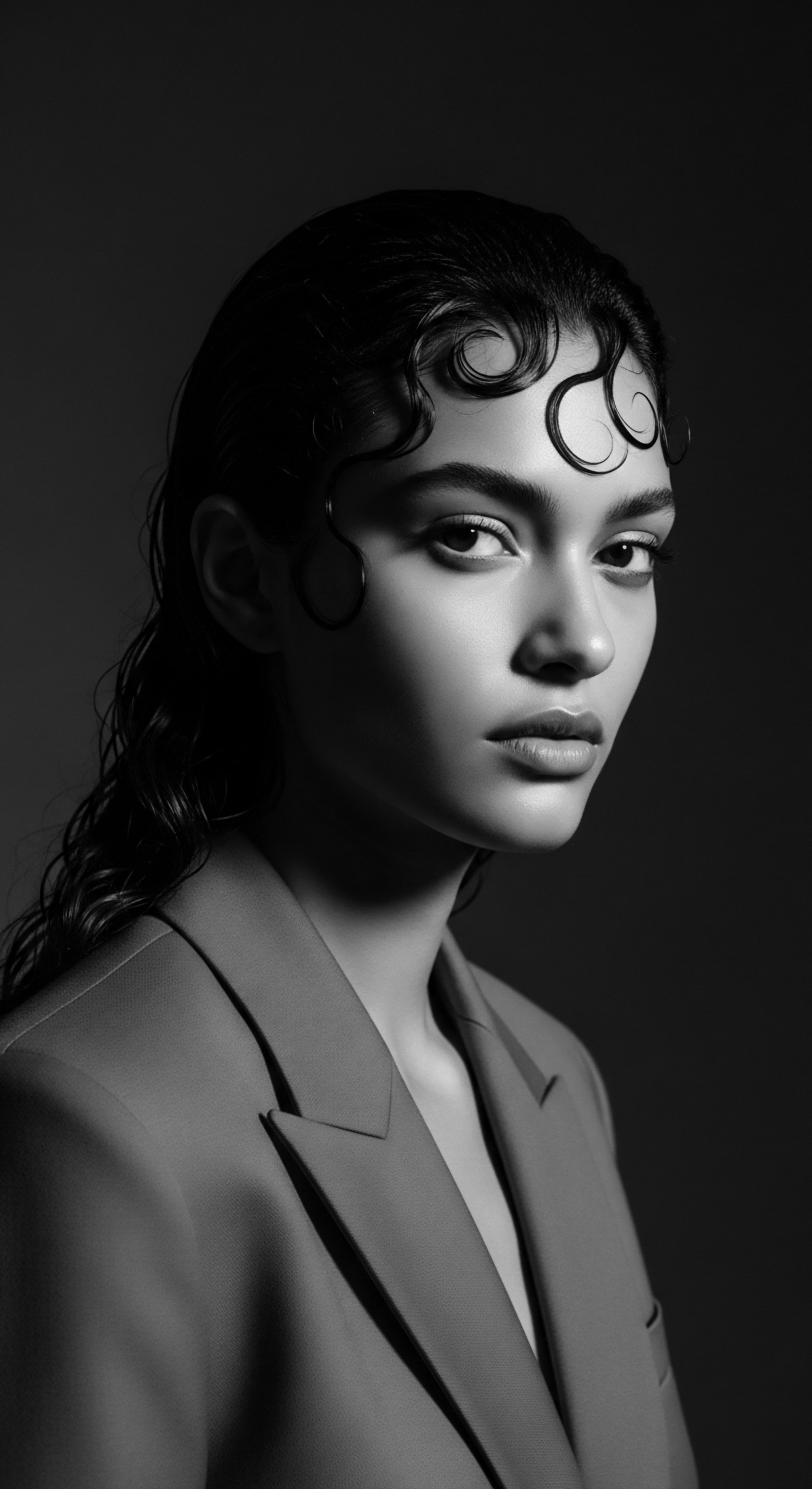
Roots
To stand beneath the sun’s unyielding gaze, feeling its warmth but sensing its quiet intensity upon each coil, each strand – this is a familiar experience for those whose heritage threads through textured hair. For centuries, our ancestors, rooted in lands where the sun reigned supreme, understood a deep truth ❉ protection was not an afterthought but a profound act of care, a legacy passed through hands and generations. The question of which traditional ingredients shield textured hair from sun damage reaches beyond simple science; it asks us to listen to the echoes from the source, to the wisdom of elders who intuitively grasped the subtle language of botanicals. How does ancestral understanding align with contemporary knowledge of hair’s resilience in the face of solar exposure?

Hair’s Ancestral Architecture and Solar Exposure
Textured hair, in its myriad forms, possesses a unique architecture. The elliptical shape of the follicle, the varied patterns of curl, and the intricate cuticle layers all play a role in how light interacts with the hair shaft. While melanin provides some inherent defense against ultraviolet radiation in both skin and hair, prolonged exposure can still lead to protein degradation, color alteration, and a significant loss of moisture.
Ancestral communities, living intimately with their environments, recognized these vulnerabilities long before microscopes revealed cellular structures. Their daily rituals were a testament to this acute observation.
Ancestral knowledge of botanicals provided a primary defense against sun’s effects on textured hair, long preceding modern scientific scrutiny.
The earliest practices of hair care were often intertwined with survival. For communities dwelling in equatorial regions, guarding against the sun’s strength was a constant. This historical context reveals a fundamental understanding of what hair needed ❉ a shield, not just from physical elements, but from the invisible forces of the sun. The solutions were found in the earth, in trees, and in the wisdom of those who knew how to transform nature’s bounty into protective balms.

Traditional Understanding of Sun Damage
Long before the scientific terms UVA and UVB entered our lexicon, ancestral communities observed the tangible effects of sun on hair. They witnessed hair becoming brittle, losing its luster, and feeling rough to the touch. This observational knowledge, honed over countless generations, informed their choice of ingredients.
They sought out substances that seemed to replenish moisture, impart a sheen that suggested health, and create a physical barrier. Their practices were not based on chemical formulas but on a deep, experiential connection with the natural world and its offerings for survival and wellbeing.
- Moisture Retention ❉ Hair exposed to sun loses water, becoming dry and susceptible to breakage. Traditional ingredients were selected for their ability to seal in or replenish moisture.
- Structural Integrity ❉ Sun exposure can weaken the hair’s protein bonds. Ancestral remedies often focused on ingredients that appeared to strengthen the hair fiber.
- Surface Protection ❉ A visible film or coating on the hair was understood to offer a layer of defense against environmental stressors, including intense sunlight.

Ritual
The application of traditional ingredients was seldom a solitary, clinical act. It was often a ritual, a communal gathering, a tender exchange passed from elder to child, mother to daughter. This living heritage of care, infused with reverence for the strand, became a foundational aspect of protecting textured hair from the sun. The wisdom embodied in these practices speaks volumes, connecting us to a lineage of resilience and beauty.

Ancient Oils and Butters for Sun Defense
Across diverse African and diasporic communities, specific plant-derived oils and butters stood as guardians against the sun. These botanical treasures were not merely moisturizers; they held properties that offered protection from environmental stressors, including solar radiation.
Consider Shea Butter, sourced from the nuts of the Vitellaria paradoxa tree native to West Africa. For millennia, African women have relied on it. It possesses a mild SPF property, offering some protection from UV rays. Its rich composition of fatty acids, including stearic and oleic acids, allows it to coat the hair shaft, forming a barrier that helps lock in moisture and shield against environmental stress.
The presence of cinnamic acid esters in Shea butter contributes to its natural UV protective qualities. This butter was applied as a daily balm, worked into coils and strands to keep them supple and protected from the elements.
Baobab Oil, derived from the seeds of the majestic baobab tree, is another powerful ingredient traditionally used for sun-exposed hair. Found across the African savanna, this oil contains tocopherols, which are antioxidants that combat free radicals generated by sun exposure. It also contains phytosterols and saturated palmitic acid, which support the hair’s external layer and help reduce water loss.
The nourishing and protective qualities of baobab oil have been cherished by African communities for centuries, making it a staple for hair exposed to intense sun. It aids in strengthening hair and offers protection from UV damage.
The use of Coconut Oil, prevalent in Caribbean and other tropical communities, speaks to a similar ancestral wisdom. Its ability to penetrate the hair shaft and reduce protein loss makes it a valuable asset in hair health, especially in climates with strong sun and humidity. Caribbean communities historically utilized coconut milk and oil to hydrate and fortify hair, with remedies designed to guard against sun damage and dryness.
The historical use of plant oils and butters like Shea, Baobab, and Coconut demonstrates a deep, inherited understanding of solar protection.

Protective Styling as an Ancestral Shield
Beyond topical applications, traditional styling practices themselves provided a physical barrier against the sun. The art of hair braiding, for example, stretches back through generations, serving functional and symbolic purposes alike. In the scorching African sun, tightly woven braids offered protection from heat while allowing airflow. Hair wrapping, too, stands as a testament to cultural resilience and identity.
In many North and Central African communities, women have worn wraps to protect their hair from the sun, simultaneously expressing their cultural identity. These head coverings, from the intricate gele of West Africa to the vibrant turbans of the Caribbean, were not merely decorative; they were a dynamic extension of hair care, guarding delicate strands from the sun’s relentless presence.
| Traditional Method Shea Butter Application |
| Geographic Origin West Africa |
| Primary Protection Mechanism UV absorption, moisture seal, protective coating |
| Traditional Method Baobab Oil Treatments |
| Geographic Origin African Savanna |
| Primary Protection Mechanism Antioxidant properties, strengthening hair fiber, UV protection |
| Traditional Method Coconut Oil Rituals |
| Geographic Origin Caribbean, Tropical Asia |
| Primary Protection Mechanism Moisture retention, protein loss reduction, barrier formation |
| Traditional Method Hair Braiding |
| Geographic Origin Various African cultures, African Diaspora |
| Primary Protection Mechanism Physical shielding from direct sun, reduced exposure of individual strands |
| Traditional Method Head Wrapping |
| Geographic Origin Throughout Africa, African Diaspora |
| Primary Protection Mechanism Physical barrier for hair and scalp, cultural expression |
| Traditional Method These ancestral practices illustrate ingenious, holistic approaches to sun defense, deeply woven into daily life and cultural identity. |
This dual approach – internal protection through botanical applications and external protection through artful styling – underscores the comprehensive nature of ancestral hair care. It reveals a sophisticated, generations-old understanding of environmental factors and hair health that finds contemporary validation.

Relay
The wisdom passed down through ancestral lines, in whispers and in actions, continues its relay into modern understanding. Traditional ingredients, once understood through observation and collective experience, now yield their secrets to scientific inquiry, revealing how deeply rooted practices hold profound biological truths. This intersection of inherited knowledge and contemporary science speaks to the enduring authority of textured hair heritage.

Botanical Chemistry and Sun Defense
The sun’s ultraviolet rays, specifically UVA and UVB, pose significant threats to hair. UVA rays penetrate the hair shaft, causing color fading and dryness, while UVB rays damage the hair’s protein structure, leading to breakage. Traditional ingredients, unbeknownst to their early users of specific molecular compositions, often contain compounds that actively mitigate these effects.
Consider Moringa Oil, derived from the seeds of the Moringa oleifera tree, native to parts of Africa and India. This light, easily absorbed oil is rich in antioxidants, including vitamins A, C, and E, which combat free radicals generated by UV exposure. It forms a protective barrier around the hair, shielding it from pollutants and UV radiation.
Moringa oil’s composition includes over 70% oleic acid, enabling it to penetrate deep into the hair fiber, providing profound hydration and protecting hair color from UV rays. Its presence in traditional regimens for hair wellness is a testament to its protective attributes.
Another powerful, historically utilized ingredient is Amla Oil, extracted from the Indian gooseberry. It is rich in antioxidants and works to strengthen hair follicles at the root, potentially aiding in new growth. While more commonly associated with strengthening and preventing premature graying in Ayurvedic traditions, its antioxidant capacity lends itself to overall hair resilience, including defense against environmental stressors like the sun. The wealth of nutrients in such oils speaks to an intuitive, generational grasp of holistic hair wellness.

How Do Antioxidants in Traditional Oils Counter Solar Stress?
Solar radiation generates free radicals, unstable molecules that damage hair proteins and lipids, leading to weakened strands and color fade. The presence of antioxidants in traditional ingredients helps neutralize these free radicals. For instance, the tocopherols (Vitamin E) in baobab oil and the spectrum of antioxidants in moringa oil directly absorb UV light energy and prevent UV-induced harm.
This protective action is akin to an internal shield, preserving the hair’s vitality even under challenging sun exposure. These findings validate the ancestral choices made in crafting sun-protective hair elixirs.

Historical Data and Hair Resilience in the Diaspora
The historical context of textured hair care, particularly within the African diaspora, provides a compelling case study for the efficacy of traditional practices. During the transatlantic slave trade, Africans were forcibly stripped of their cultural markers, including their hairstyles. Despite these dehumanizing acts, enslaved Africans found ways to preserve and adapt their hair traditions, often utilizing ingredients and techniques passed down through generations to maintain hair health amidst harsh conditions, including relentless sun exposure in the fields.
A powerful, less commonly cited narrative illustrating this resilience comes from the meticulous hair care regimens observed among enslaved women in the American South. Despite deprivation, many cultivated small gardens or relied on communal knowledge to access ingredients like castor oil , lard (often infused with herbs) , and various plant-based fats . These were applied to hair not just for conditioning, but as practical barriers against the sun, dust, and physical labor (Byrd and Tharps, 2001, p. 55).
The practice of daily oiling, a tradition that migrated with them, helped to coat the hair, reducing moisture loss and offering a degree of protection against solar drying and brittleness common in agricultural settings. This sustained ingenuity, under unimaginable duress, underscores the deep cultural significance and practical efficacy of these traditional protective ingredients.
- Castor Oil ❉ A thick oil, it was historically used for conditioning and strengthening hair, and in a climate of intense sun, its viscosity would have offered a substantial physical coating, reducing direct UV impact and moisture evaporation.
- Plant-Based Fats ❉ Whether derived from indigenous plants or adapted from available resources, these fats served as emollients, helping to maintain hair suppleness and create a physical barrier against environmental elements.
The evolution of African hair care practices in the diaspora, often blending traditional African knowledge with the botanical resources of new lands, stands as a testament to cultural adaptability and the enduring search for hair wellness. The deliberate act of oiling hair daily, as noted in various historical accounts, reflects a profound ancestral understanding that fats and oils formed a vital shield against environmental aggressors. This ritual, born of necessity and passed through generations, demonstrates a deep, practical application of heritage to hair defense.

Reflection
The journey through traditional ingredients shielding textured hair from sun damage reveals more than just a list of botanicals; it unveils a profound dialogue between ancestral wisdom and enduring resilience. Each coil and strand carries the weight of history, a living archive of ingenuity and care. The choice of shea butter, baobab oil, moringa oil, or the purposeful crafting of braids speaks to generations who understood the intimate connection between environmental elements and hair health long before scientific classification existed.
This is the soul of a strand, a testament to inherited knowledge that continues to guide our understanding of textured hair. The practices and ingredients that once served as vital protections in sun-drenched lands remain relevant, offering lessons in holistic well-being that transcend time. Our exploration reaffirms that the legacy of textured hair care is not static; it is a vibrant, evolving narrative, continuously informing how we honor and care for our hair today.

References
- Byrd, A. D. & Tharps, L. L. (2001). Hair Story ❉ Untangling the Roots of Black Hair in America. St Martin’s Griffin.
- Davis-Sivasothy, A. (2011). The Science of Black Hair ❉ A Comprehensive Guide to Textured Hair Care. Sivasothy.
- Kedi, C. (2018). Beautifying the Body in Ancient Africa and Today. Kedi Publications.
- Patton, T. O. (2006). “Hey Girl, Am I More Than My Hair? ❉ Black Women and Their Struggles with Beauty, Body Image, and Hair.” Journal of Black Studies.
- Olumide, Y. M. (2015). The Vanishing Black African Woman ❉ Volume One. African Books Collective.
